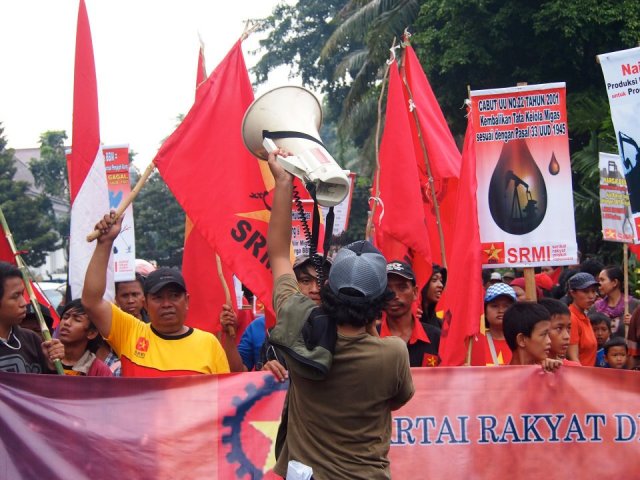
Indonesia has been rocked by an explosion of popular protest against fuel price rises right around the country.
Indonesian Police Watch says between March 23 and 26 alone, there were 1063 demonstrations, 16 police stations were damaged and 750 protesters were arrested.
Green Left Weekly's Peter Boyle spoke to Dominggus Oktavanius, secretary-general of the Peoples Democratic Party (PRD) of Indonesia on April 4 about the outbreak of mass unrest.
* * *
There have been some very big and militant demonstrations against the SBY government’s plan to increase the price of fuel by 33%. Where and when were the biggest demonstrations and which groups organised them?
During March, militant demonstrations erupted across all the major cities in Indonesia. There were a total of 1063 actions compared with just 12 and 16 demonstrations in the two previous months according to police data. Almost all these actions were in rejection of the government’s plans to raise fuel prices.
The biggest demonstrations occurred in Makassar between March 21 and 30. More than 30,000 people took part in protests on March 29-30. The students [protesting] got support from their lecturers and the campus authorities, so all the big universities were closed down.
Then, in Medan (March 28-29), Jakarta (March 21, 27 and 30), and Surabaya (March 23) -- each of which involved tens of thousands of people. The most intense action took place in Jakarta, East Java, Central Java and South Sulawesi.
It’s hard to identify a particular group that organised all these actions. The actions in Makassar were mainly by students and the urban poor. The National Student League for Democracy (LMND) and the Peoples Democratic Party (PRD) took part in it, especially around the ’45 Campaign for Article 33 of the Constitution.
This campaign promotes a section of the constitution from Indonesia’s 1945 revolution (through which Indonesia won its independence from the Dutch colonial regime) that decreed the foundation of the national economy as a transition to a socialist economy.
The biggest demonstrations in Jakarta were organised by an alliance of trade unions and student groups. But it should be noted that some opposition parliamentary parties, especially the Indonesian Democratic Party of Struggle (PDIP), also promoted the mobilisation among their supporters.
What would be the effect of a 33% price rise on the life of the mass of Indonesian people?
Such a fuel price hike would certainly affect the price of the basic necessities of life, ranging from transport, food, clothing, housing, education, and so forth.
Workers will be forced to bear the additional burden of a 10-20% rise in the cost of living. About 80% of the total number of workers in Indonesia who earn below $214 a month (two million rupiah) will be hit hard.
Poor people who work in the informal sector -- in transport and fishing -- will suffer the worst impacts. They are the largest class of fuel users for economic activity. The conditions of poverty in Indonesia are severe enough without a rise in fuel prices.
This is why on March 8, the PRD sent a direction to all of its cadre to carry out huge propaganda campaign against the proposed April 1 fuel price hike. It called for a maximum mass mobilisation on March 30 and 31 in all cities where the PRD organises.
The police used violence at some of these demonstrations. Can you tell us about this?
Violence by the police against the demonstrations took place almost equally in all regions. There are two reasons for this violence: first, the government does not have an answer to the demands of the masses, nor could it dodge critical questions about these price rises.
This repression is similar to the actions of Western governments against the Occupy movement and the authorities' attempts to evicted the Tent Embassy camps by Aborigines in Australia.
Second, in order to have a stronger reason to carry out repression, the police infiltrated their agents into the demonstrations to provoke unrest, by throwing rocks at the police or setting fire to vehicles. We saw for ourselves how a group of people infiltrated the demonstration to provoke violence in Gambir, Jakarta, on March 27. But this only legitimises the use of unprovoked police repression against protesters.
Also, it seems that the Indonesian police are trying to prove they are capable of being strong protectors for corrupt rulers and their masters in the West.
Several new types of weapons and ammunition were used against demonstrators. We experienced a new kind of gas that the police shot into in the crowds. It exploded and, besides stinging our eyes, it burned our bodies.
After the protest the parliament adopted a law delaying the price rise. Is this a real concession to the protesters? Or is it a trick?
Actually this was just a hoax, because the decision of the House of Representatives (DPR) has handed the authority to the government to raise fuel prices.
The new law says the government may raise fuel prices according to price changes on NYMEX on Wall Street if the price of Indonesian Crude Oil exceeds the subsidised Indonesian fuel price by an average of 15% for six continuous months. This policy is contrary to the Article 33 of the Constitution of 1945.
After the decision of the DPR, the demonstrations have become smaller. Do you think they will continue and get bigger again?
The parliament’s decision just set off a time bomb, so we believe the demonstrations will expand when the inevitable price rise brings a new momentum. Each demonstration is actually a response to the accumulation of many severe problems for the ordinary people. A rise in fuel prices acts as the trigger for protests around many other problems that already exist.

BELOW: One of the 1063 fuel price protests held in Indonesia in March 2012. Photos by Sari Putri.




